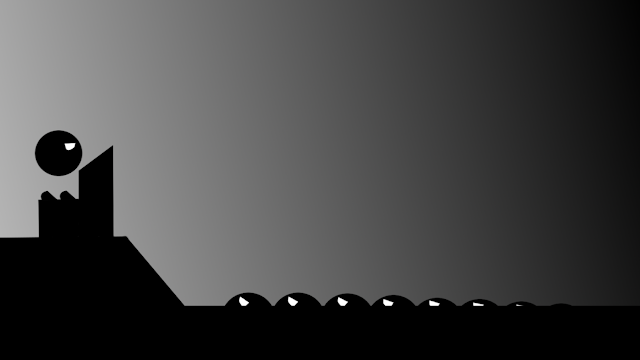I hope you enjoy this, for those of you who are interested, the script I had in front of me is printed below.
So the extent of the
feedback I’ve had on this one is that it didn’t work on one guy’s
computer running 64-bit Windows, so if anyone watching this is
running this so-called operating system, I would appreciate if you
would try to run it and see if it works.
Also, regardless of
what operating system you’re running, I would recommend that you
play Homogeny and Monotony, the prequels to this game, and if you’re
especially interested take a look at their associated symbolic
analyses.
The game does open
with the word “regret”, which directly follows on from the ending
scene of Banality, which ends with the final title card “regret”.
This is in reference to the central theme of Monotony, which is the
character trying to reconnect with their estranged peers.
If you watched the
symbolic analysis of Banality, you might recall that the bed
represented the character’s comfort zone, which it still does in
this game. The character is pressed against their bed, sort of
symbolizing that they are trying to get back into their comfort zone
– again referencing the idea of reconnecting and becoming “normal”
again.
The character’s
opening line is “If nothing else, Sisyphus was happy”. For those
of you who don’t know who Sisyphus is, he was a mythological greek
guy who was cursed to roll a boulder up a hill, only for it to roll
back down, leading to the fairly popular phrase, “One must imagine
Sisyphus happy”. The implication here is that despite the otherwise
lack of real substantial content behind social activities, it’s
easy to indulge in.
To be honest, I
regret not making this area more clear in terms of direction- you are
actually meant to touch the people in this one. Touching the people
plays the reverse of the sequence in Banality, where the metaphorical
representation of you is being raised up on a platform rather than
descending. However, this time it breaks when you get to the top, and
you fall down. This represents the idea that it’s impossible for
the character to ever return to normalcy, and they fall back down
despite their best efforts.
The term
“desperation” as shown on the screen should be fairly
straight-forward, it makes reference to the idea that the character
is desperate to re-connect with the aforementioned estranged peers.
Something I probably should have pointed out a bit of time ago- the
character is intended to have strange or otherwise awkward speaking
patterns, to sort of exemplify how they are so different from other
people that they literally cannot relate to them even on the most
basic terms of language. To be quite honest, “what a terrible
purgatory” is totally flavour text.
This scene shows the
character getting up from the platform, so obviously it’s implied
that the player is now controlling the metaphorical representation of
the character from the broken platform beforehand.
The character is
then confronted with a button and door puzzle, like in Banality and
Yet Another Puzzle Game. It’s meant to create the idea that the
character is able to look at the things separating him from the other
people, solve them easily, but still finds himself inexplicably
distant from them when they start running after the door opens.
At this point, the
other person has escaped and the character is left to find another
route around the same obstacle, which in this case is over this
building here. Also, the music at this point becomes somewhat glitchy
and distorted, which again is mainly to convey the aesthetic that the
character’s mental state isn’t good or orderly.
This next sequence
is fairly dense in terms of meaning in that you have the title card
with the word “quickly” repeated on it, the shaking screen and if
you don’t pause then you will eventually come to the end of the
background. The title card “quickly” is designed to create a
sense of urgency that the character must continue to try to
re-connect with people, the shaking screen represents the character’s
unsteady or ineffectual effort to keep trying, and the short peak of
the end of the background represents the idea that the character, in
the process of their efforts, has seen things which do not make sense
to them in the same sense that a three dimensional object doesn’t
make sense to a two dimensional creature.
The character is not
present at all in the bedroom sequence, which represents the idea
that they have abandoned their comfort zone totally.
The title card
“broken brilliance” is a term that has become so removed from its
origin in my mind that there is no point trying to explain its
origin, but it is in itself a fairly poetic concept. This will be
left as an exercise to the viewer.
The colourful
glitchy artifacts around the screen again represent things and
concepts which don’t make sense to the character, and were never
apparent or visible in their own “world”. The things they
interact with would have never contained things like this, as
demonstrated in the previous games being entirely monochromatic. This
is linked with the term “broken brilliance”- the “game” is
broken, but it’s worth it for the sake of its visual appeal.
The term “keep
moving” is fairly direct in terms of meaning, it’s a direct
instruction for the player to continue moving towards the end of the
level.
The ending text is
similarly very straight-forward in its meaning.




